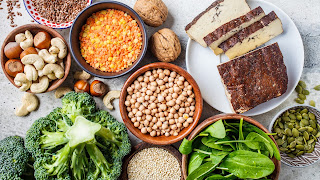Top sources of plant-based protein
More and more people are interested in following vegetarian or vegan diets or reducing their use of animal products. A shift away from animal products is getting easier with more fortified and nutritious plant-based foods available.
A person may try a vegan diet for health, animal welfare, or religious reasons. In 2016Trusted Source, the Academy of Nutrition and Dietetics stated that a vegetarian or vegan diet could provide all the nutritional requirements of adults, children, and those who were pregnant or breast-feeding.
Even so, getting enough protein and essential vitamins and minerals can be harder for people who do not eat meat or animal products. A person must plan ahead to ensure they get enough protein, calcium, iron, and vitamin B-12, which people on an omnivorous diet get from animal products.
Read on for a list of some of the best plant-based foods for protein. We also discuss the differences between animal and plant proteins, and whether plant-based protein powders can be good sources of protein.
Fifteen best plant-based proteins
The right plant-based foods can be excellent sources of protein and other nutrients, often with fewer calories than animal products.
Some plant products, such as soy beans and quinoa, are complete proteins, which means that they contain all nine essential amino acids that humans need. Others are missing some of these amino acids, so eating a varied diet is important.
The following healthful, plant-based foods have a high-protein content per serving:
1. Tofu, tempeh, and edamame
Soy products are among the richest sources of protein in a plant-based diet. The protein content varies with how the soy is prepared:
firm tofu (soybean curds) contains about 10 g of protein per ½ cup
edamame beans (immature soybeans) contain 8.5 g of protein per ½ cup
tempeh contains about 15 g of protein per ½ cup
Tofu takes on the flavor of the dish it is prepared in so that it can be a versatile addition to a meal.
People can try tofu, as a meat substitute, in a favorite sandwich or soup. Tofu is also a popular meat substitute in some dishes, such as kung pao chicken and sweet and sour chicken.
These soy products also contain good levels of calcium and iron, which makes them healthful substitutes for dairy products.
2. Lentils
Red or green lentils contain plenty of protein, fiber, and key nutrients, including iron and potassium.
Cooked lentils contain 8.84 g of protein per ½ cup.
Lentils are a great source of protein to add to a lunch or dinner routine. They can be added to stews, curries, salads, or rice to give an extra portion of protein.
3. Chickpeas
Cooked chickpeas are high in protein, containing around 7.25 g per ½ cup.
Chickpeas can be eaten hot or cold, and are highly versatile with plenty of recipes available online. They can, for example, be added to stews and curries, or spiced with paprika and roasted in the oven.
A person can add hummus, which is made from chickpea paste, to a sandwich for a healthful, protein-rich alternative to butter.
4. Peanuts
Peanuts are protein-rich, full of healthful fats, and may improve heart health. They contain around 20.5 g of protein per ½ cup.
Peanut butter is also rich in protein, with 3.6 g per tablespoon, making peanut butter sandwiches a healthful complete protein snack.
5. Almonds
Almonds offer 16.5 g of protein per ½ cup. They also provide a good amount of vitamin E, which is great for the skin and eyes.
6. Spirulina
Spirulina is blue or green algae that contain around 8 g of protein per 2 tablespoons. It is also rich in nutrients, such as iron, B vitamins — although not vitamin B-12 — and manganese.
Spirulina is available online, as a powder or a supplement. It can be added to water, smoothies, or fruit juice. A person can also sprinkle it over salad or snacks to increase their protein content.
7. Quinoa
Quinoa is a grain with a high-protein content, and is a complete protein. Cooked quinoa contains 8 g of protein per cup.
This grain is also rich in other nutrients, including magnesium, iron, fiber, and manganese. It is also highly versatile.
Quinoa can fill in for pasta in soups and stews. It can be sprinkled on a salad or eaten as the main course.




No comments:
Post a Comment